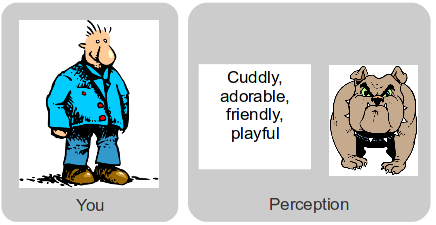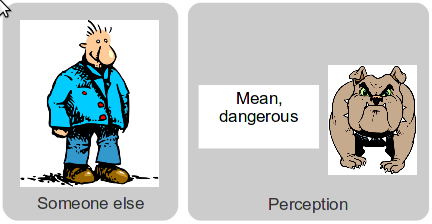Examples of models: “beliefs and expectations filter your perception”
[This post is part of a series on The Model — my model for the human emotional system designed for use in leadership, self-awareness, and general purpose professional and personal development — which I find the most effective and valuable foundation for understanding yourself and others and improving your life. If you don’t see a Table of Contents to the left, click here to view the series, where you’ll get more value than reading just this post.]
Let’s look at another example of how we use models in more depth. As with yesterday, after treating the example I’ll describe the lessons it teaches.
Imagine you grew up with a pet pit bull. You might see it as an adorable pet.
 Someone else who never grew up with one but only heard sensationalist stories about them might see them as dangerous animals.
Someone else who never grew up with one but only heard sensationalist stories about them might see them as dangerous animals.
 Same animals, different models, different perceptions of the world. Personally, I know people with both sets of models.
Same animals, different models, different perceptions of the world. Personally, I know people with both sets of models.
We don’t usually notice our beliefs, we just believe the world is how we perceive it. No one looks at a dog and thinks, “It looks one way to me but I wonder how another person’s experiences and beliefs might lead them to see it differently.” We tend to forget how our beliefs and expectations filter what we see.
As with yesterday, one’s model could create self-reinforcing behavior in one’s environment. That is, you behaving calmly could lead a mean dog to behave calmly. Someone else’s nervousness could lead a calm dog to growl menacingly.
Today I’ll point out that if we can affect our environments through our models and their resulting behavior and we can choose our models consciously, we can choose them based on the outcome we want, at least in part. Why wouldn’t we?
This model results in the strategy, for me,
Always interpret everything positively.
Words to live by!
The strategy to always interpret everything positively rewards and motivates me so I adopt the model as “true†and implement the strategy without thinking about it. I’m not saying the model is true because it leads to a strategy I like. I’m saying it feels true. I’ll further say many beliefs you feel are true, you feel are true because of the strategies they lead to.
Though today I’m mainly writing to illustrate properties of models, I will add that I use the strategy “always interpret everything positively” every day. I don’t apply it blindly and try to pet every pit bull I see, but when I recognize a choice of models, I think of the consequences of adopting them. Then I choose among them mainly by how positive their consequences are — or, more precisely, how they meet my values.
We can’t predict outcomes perfectly accurately, so we often have to guess as best we can, but this strategy brings about desired outcomes better than any other I know of.
People often prefer to stick with whatever model they hit on first. They consider changing models something like revising history. But being first doesn’t make a model special or any less flawed than any other.
I call not changing models or even considering changing them “reactive.” It means you abdicate a major part of your motivation. I consider the practice of considering changing them and doing so is a major part of self-awareness and emotional intelligence. Leaders do so. Followers don’t, which motivates them to follow those who do.
Lessons learned
Besides repeating yesterday’s lesson on models, we see
- since we can predict outcomes and choose models, we can choose models based on their outcomes
- choosing based on what outcome best meets your values best improves your life, as far as I can tell, at least
- we tend to feel models are true when the outcomes they lead to reward us
Another lesson, or at least a recommendation:
Always interpret everything positively.
Read my weekly newsletter

On initiative, leadership, the environment, and burpees
Pingback: Models: the active view, part 2 | Joshua Spodek
Pingback: Examples of models: “Everybody does their best according to their abilities and perception of their environment†» Joshua Spodek
Pingback: The Model: summary | Joshua Spodek